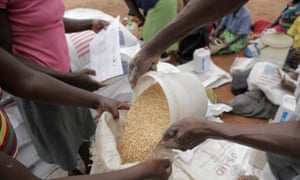
Children in Mafomoti village, in Zimbabwe’s Mwenezi district, wait while their mothers prepare their only meal of the day. Photograph: Aaron Ufumeli/EPA
Poverty has reached unprecedented levels in Zimbabwe, with more than 70% of Zimbabwean children in rural areas living in poverty, a UN study has found.
The report, compiled by Unicef and the Zimbabwe National Statistics Agency, shows high levels of privation in rural areas, where 76.3% of children live in abject poverty. Statistics seen by the Guardian suggest that almost half of these children do not have enough of the right food to eat.
Humanitarian organisations have warned that if nothing is done to address food security issues in Zimbabwe, child poverty will escalate further.
“In rural areas, all land use areas have [a] high prevalence of poor children, but communal and resettlement areas are slightly worse; urban areas in rural provinces also have high rates of child poverty,” said the report’s authors.
Child poverty is more prevalent in Mashonaland Central, Manicaland and Matabeleland North.
Laylee Moshiri, a Unicef representative in Zimbabwe, urged the country’s government to monitor child poverty.
“Unicef calls on the government of Zimbabwe to recognise child poverty as a national policy priority and protect children from its most devastating effects throughout its reform agenda,” said Moshiri.
“We hope that our support for the country’s efforts to assess and report on … monetary and multidimensional child poverty measurements will inform a national policy framework for poverty reduction that has children at its centre, as part of the 2030 agenda.”
A woman pours food aid into a sack at a distribution point for Mafomoti primary school in Zimbabwe’s Mwenezi district. Photograph: Aaron Ufumeli/EPA
Zimbabwe is facing one of the most severe droughts in its history. About 5.5 million people in rural Zimbabwe face starvation.
According to Reuters, Zimbabwe’s agriculture minister, Perrance Shiri, said this week that the country has less than 100,000 tonnes of grain in its strategic reserves. The grain reserve has a 500,000-tonne capacity, but has been run down after a poor harvest. Zimbabwe consumes 80,000 tonnes of maize every month.
The World Food Programme says it needs a further $200m (£152m) to meet hunger needs in the country.
The report’s authors called on the country to adopt policies such as feeding programmes and food aid.
With households fast running out of food, most children of school age are in danger of starvation. Schoolchildren often faint during class, according to humanitarian organisations, heightening calls for food aid in schools.
Zimbabwe has a young population, with 48% of people under the age of 18.
Poverty remains a predominantly rural problem, said the report’s authors, who estimated that about 20% of urban children live in poverty.
The World Bank estimates that extreme poverty in Zimbabwe has risen over the past year, from 29% in 2018 to 34% in 2019, an increase from 4.7 to 5.7 million people. The bank predicts levels will continue to rise in 2020.
The surge in poverty has been attributed to acute food shortages as a result of the current economic crisis and the crippling effects of the El Niño-induced drought on agricultural productivity.
Hilal Elver, the UN special rapporteur on the right to food, last year warned that Zimbabwe was on the verge of manmade starvation, adding that children would be the most affected as guardians fail to provide a balanced diet.
She said the drought had also affected children’s health, with nearly 90% of Zimbabwean infants experiencing malnutrition and stunted growth.
